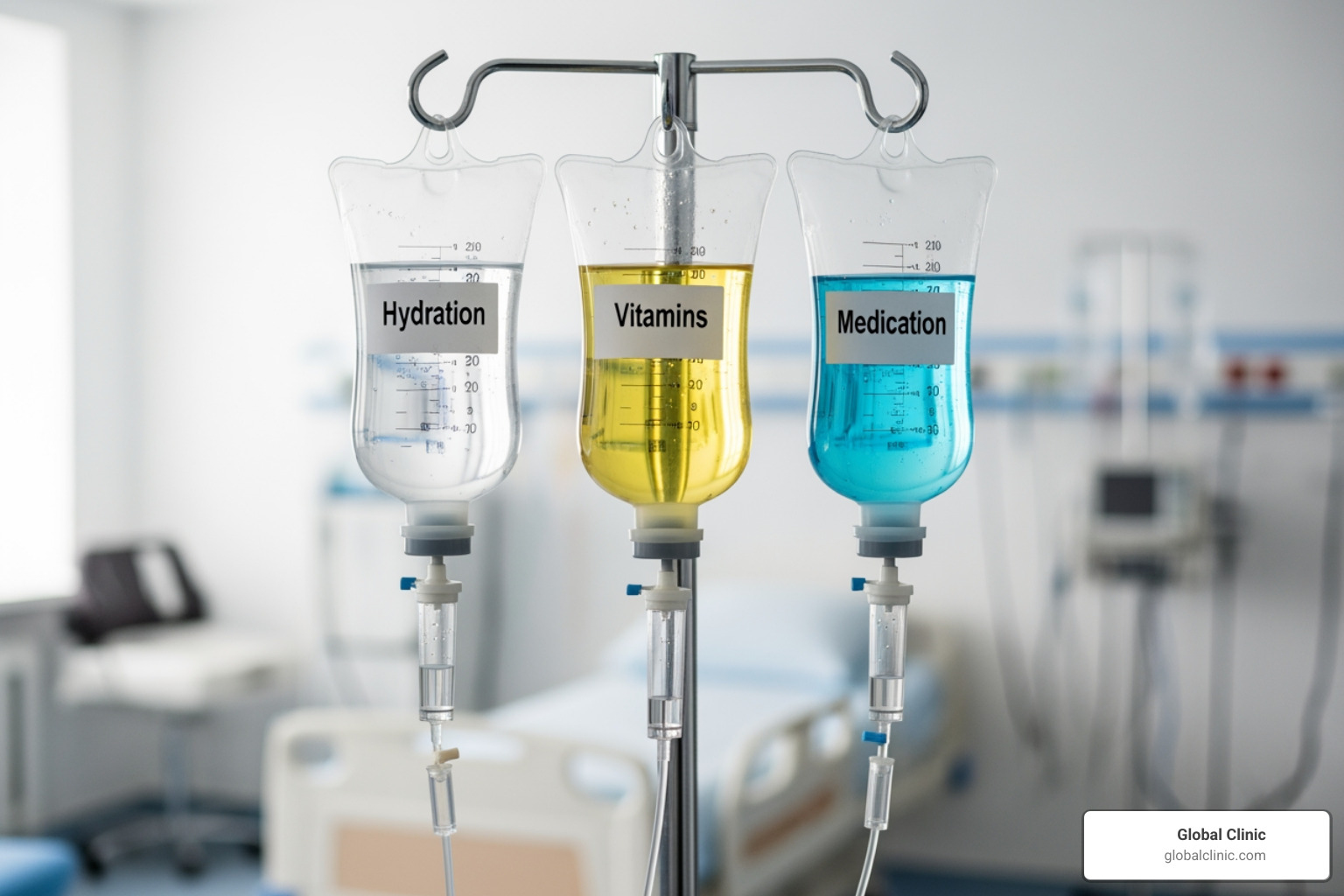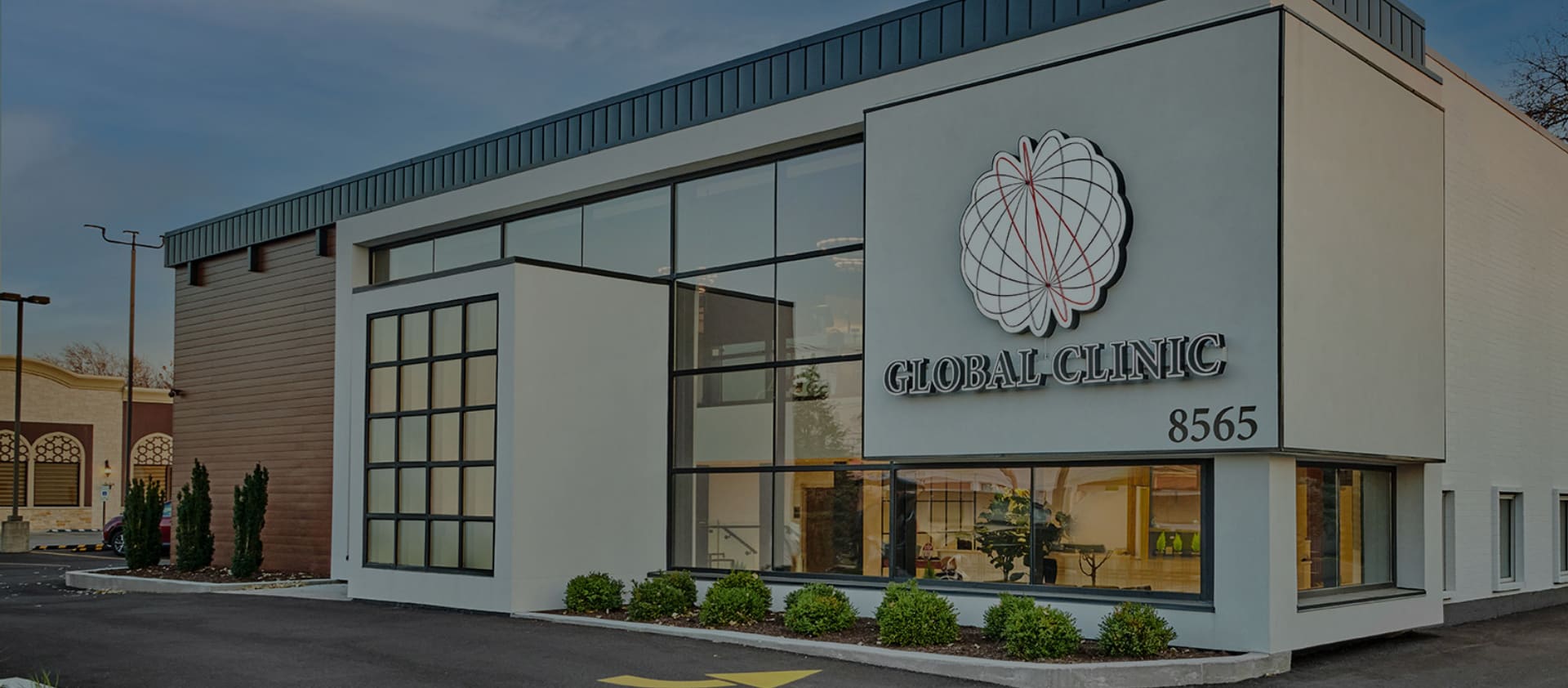What You Need to Know About IV Infusions
IV Infusions are medical treatments that deliver fluids, medications, vitamins, or nutrients directly into your bloodstream through a vein. Here’s what matters most:
- How they work: A small catheter is inserted into a vein, allowing substances to enter your circulatory system immediately.
- Main medical uses: Treating dehydration, delivering medications (like antibiotics or chemotherapy), correcting nutrient deficiencies, and supporting recovery after surgery.
- Speed advantage: Unlike oral supplements that provide only 15-20% absorption, IV therapy delivers nearly 100% of nutrients directly to your body.
- Common types: Medical IV fluids (saline, electrolytes), medication infusions, nutritional support, and wellness vitamin cocktails.
- Session duration: Most treatments take 30-90 minutes depending on the type of infusion.
- Who administers: Licensed healthcare professionals like registered nurses, paramedics, or physicians.
The key difference? IV therapy bypasses your digestive system entirely, making it the fastest way to rehydrate, deliver medication, or replenish nutrients when your body needs help quickly.
While its history dates back centuries, IV therapy became a safe, widespread medical staple in the 1950s. It’s now the most common invasive procedure in healthcare, essential for restoring the body’s fluid balance—which is about 60% water—when illness or injury prevents normal hydration and nutrient absorption.
Recently, IV infusions have entered the wellness space in “drip bars” offering vitamin cocktails for hangovers or athletic recovery. It’s important to distinguish these elective treatments from medically necessary IV therapy, as not all are supported by strong scientific evidence.
I’m Ana Vinikov, Practice Manager at Global Clinic. I’ve seen how IV Infusions, when used appropriately within a comprehensive treatment plan, can support healing for patients managing chronic pain, recovering from injury, or addressing nutritional deficiencies.

IV Infusions vocabulary:
Understanding the Core Principles of Intravenous Fluids
The modern story of IV therapy began in 1830 when Dr. Thomas Latta used intravenous fluids to save cholera patients from severe dehydration, proving that direct fluid replacement could be life-saving. However, it wasn’t until the 1950s, with improved sterile techniques, that it became a standard of care. The principle is simple: your body is about 60% water, and this balance is vital for temperature regulation, nutrient transport, and waste removal. When dehydration occurs from illness, injury, or surgery, and drinking fluids isn’t enough, IV Infusions restore that balance quickly by bypassing the digestive system.
At Global Clinic, we understand that effective treatment sometimes requires advanced approaches. You can learn more info about our approach to regenerative medicine to see how we combine various therapies for optimal results. For those interested in diving deeper, the scientific research on IV fluids from Cleveland Clinic offers excellent, evidence-based information.
Types of IV Fluids and How They Work
Healthcare providers choose from two main categories of IV fluids based on a patient’s specific needs.
Crystalloid solutions contain small molecules like salts and sugars. Normal saline (0.9% sodium chloride) is used for general rehydration. Lactated Ringer’s contains multiple electrolytes, making it ideal for surgery or trauma. Dextrose in Water (D5W) provides hydration and a small amount of sugar for energy.
Colloid solutions have larger molecules like albumin (a blood protein) or hetastarch that stay in the blood vessels longer. This makes them effective for expanding blood volume, such as after severe burns or significant blood loss.
Your healthcare provider carefully considers your specific situation before choosing which fluid to use. It’s not a one-size-fits-all decision—it depends on your condition, what caused your fluid imbalance, and your overall health.
How IV Therapy Compares to Other Administration Routes
The delivery method is as important as the substance itself, and IV therapy is best in speed and efficiency.
Oral supplements and medications face a difficult journey through the digestive system, where stomach acid and liver metabolism (the “first-pass effect”) can reduce absorption to as little as 15-20%. Intramuscular (into muscle) and subcutaneous (under the skin) injections are faster than oral routes but still don’t offer immediate effects.
IV Infusions, however, deliver substances directly into the bloodstream with 100% bioavailability. The effects are felt within minutes, which is why it’s the standard for emergencies, rehydration, and delivering medications that would be destroyed by the digestive system. It’s precision medicine at its most efficient.
If you’re curious about other therapeutic delivery methods we offer, you can find more info about other injection therapies that might complement your treatment plan.
Medical Applications and Types of IV Infusions

In any clinical setting, IV Infusions are a common sight, delivering everything from simple saline to life-saving drugs. At Global Clinic, we use these treatments as powerful medical tools across a wide spectrum of healthcare needs.
Medically Necessary Uses for IV Infusions
The most critical applications of IV Infusions are rooted in genuine medical necessity. These aren’t optional wellness treatments—they’re essential interventions.
- Dehydration: When severe illness like vomiting or diarrhea prevents you from keeping fluids down, IV rehydration quickly restores fluid and electrolyte balance.
- Post-Surgery Recovery: After surgery, IVs provide essential hydration, electrolytes, and medications while the digestive system rests and heals.
- Medication Delivery: IV administration is crucial for delivering antibiotics to fight serious infections or chemotherapy drugs to treat cancer, ensuring immediate and effective levels in the bloodstream.
- Pain Management: For chronic pain unresponsive to oral medication, IV delivery of analgesics like Ketamine can provide significant relief for conditions like Complex Regional Pain Syndrome (CRPS), fibromyalgia, and neuropathic pain, often reducing the need for opioids.
- Blood Transfusions & Nutrition: IV lines are essential for blood transfusions after trauma or surgery and for delivering Total Parenteral Nutrition (TPN) to patients who cannot absorb nutrients through their gut.
- Diagnostic Imaging: IVs are also used to administer contrast dyes for imaging studies like CT scans and MRIs, enhancing the visibility of internal structures.
Methods of IV Administration
The delivery method of an IV Infusion depends on the medication, required speed, and duration of treatment.
Continuous infusion provides a steady flow over hours or days, ideal for hydration or maintaining consistent medication levels, often managed by an infusion pump.
Intermittent infusion delivers medication at scheduled intervals (e.g., every few hours), a method common for antibiotics.
An IV bolus or push is a concentrated dose delivered over a few seconds or minutes, reserved for emergencies requiring an immediate drug effect.
Here’s how bolus and continuous infusion compare:
| Feature | IV Bolus (Push) | Continuous Infusion |
|---|---|---|
| Speed | Very rapid (seconds to minutes) | Slow and steady (hours to days) |
| Duration | One-time dose | Prolonged, uninterrupted delivery |
| Purpose | Immediate effect, emergencies | Sustained drug levels, hydration |
| Concentration | High concentration initially | Consistent concentration over time |
| Risk | Higher risk of adverse reaction (rapid) | Lower risk of acute adverse reaction |
Your medical team will carefully select the most appropriate administration method for your specific situation, balancing the need for speed with safety considerations.
The IV Therapy Procedure: From Start to Finish

It’s natural to be nervous before your first IV Infusion, but the process is typically quick and straightforward. Most patients find it’s similar to having blood drawn, only we’re delivering beneficial fluids instead of taking blood out.
Types of IV Access
Your provider will choose the best IV access point based on your treatment duration and the type of fluid being used.
- Peripheral Line (PIV): This is the standard IV, a small catheter placed in a vein in your arm or hand, used for short-term treatments like hydration or a single dose of medication.
- Central Lines (CVC): For longer treatments or harsh medications, these are inserted into larger veins in the neck, chest, or groin.
- PICC Lines: Inserted in the upper arm but extending to a large central vein, a PICC line is ideal for therapy lasting weeks or months.
- Tunneled Lines & Implantable Ports: For long-term needs (months to years), tunneled lines are surgically placed under the skin for stability, while implantable ports are placed completely under the skin and accessed with a special needle, allowing for normal activities like swimming between treatments.
The Step-by-Step Process
The basic procedure follows a careful protocol that prioritizes safety and comfort.
- Vein Selection & Disinfection: Your nurse will select a suitable vein, possibly using a tourniquet or ultrasound to make it more visible. The area is then thoroughly cleaned with an antiseptic to prevent infection.
- Cannula Insertion: You’ll feel a quick pinch as a sterile needle guides a soft plastic tube (catheter) into the vein. The needle is immediately removed, leaving only the flexible catheter.
- Securing the Line & Starting the Infusion: The catheter is taped down, and tubing connects it to the IV bag. A computerized pump often controls the flow rate, ensuring a precise and safe delivery speed.
- Monitoring: Throughout the session, a nurse will monitor you and the IV site for comfort and to prevent complications. Let them know immediately if you feel any pain or discomfort.
- Removal and Aftercare: When finished, the catheter is painlessly removed. A small bandage is applied to the site, which may have minor bruising that fades in a few days.
- Recovery Outlook: Most people feel fine immediately after, especially following hydration. We’ll provide specific aftercare instructions before you leave. The site typically heals within a day or two.
Navigating the Benefits and Potential Risks of IV Infusions
Like any medical procedure, IV Infusions have both powerful benefits and potential risks. Understanding both sides is key to making an informed decision about your care.
Medically Supervised Benefits
When administered by qualified professionals, IV Infusions offer significant advantages:
- Rapid Rehydration: IV fluids work within minutes to restore water and electrolytes, providing immediate relief from severe dehydration when oral fluids aren’t enough.
- Effective Medication Delivery: IVs ensure 100% of a medication reaches the bloodstream immediately. This is vital for antibiotics, chemotherapy, and pain management drugs that need to work fast or would be destroyed by the digestive system.
- Correcting Nutritional Deficiencies: For patients with absorption issues (e.g., from Crohn’s disease or gastric bypass), IVs deliver essential vitamins and minerals directly to the cells, bypassing a compromised gut.
For more insights, you can explore scientific research on IV fluids or see how we integrate these therapies into our approach to regenerative medicine.
Common Adverse Effects and Complications
While generally safe, complications can occur. Understanding potential issues helps prevent them.
- Infection: Though rare with sterile techniques, watch for redness, warmth, or swelling at the insertion site.
- Phlebitis: Vein inflammation can cause pain and redness along the vein. It’s usually treatable with warm compresses.
- Infiltration/Extravasation: This occurs if fluid leaks into the surrounding tissue, causing swelling and discomfort. It is more serious if the leaking fluid is a harsh medication.
- Hematoma (Bruising): The most common issue, a bruise may form at the site but is harmless and fades.
- Fluid Overload: A risk for patients with heart or kidney issues, this happens if fluids are given too quickly, causing shortness of breath or swelling. Careful monitoring prevents this.
- Air Embolism: Extremely rare due to modern safety features, this involves air entering the bloodstream.
Medical literature on common local complications of IV access provides more comprehensive information.
When to Seek Medical Attention
Your body will signal if something is wrong. Contact your provider for worsening pain, swelling, or redness at the IV site, or if you develop a fever or chills. Seek immediate medical attention for shortness of breath, difficulty breathing, or chest pain. During the infusion, alert your nurse to any headache, rash, or hives, or if the catheter feels loose. The bottom line: When in doubt, speak up. Your safety is our priority.
The Rise of Wellness IV Drips and ‘Drip Bars’

You’ve likely seen “drip bars”—spa-like lounges where people receive elective IV Infusions of vitamins and minerals. This wellness trend has moved IV therapy from the hospital to the high street, promising quick fixes for everything from hangovers to aging.
What is ‘Drip Bar’ IV Therapy?
Unlike medically necessary treatments, these infusions are chosen by healthy individuals seeking a boost. Common reasons include hangover relief, athletic recovery, beauty and anti-aging benefits, or combating jet lag. The appeal of a quick fix is strong, but it’s important to look past the marketing.
Common Blends and Their Purported Benefits
Drip bar menus often feature “cocktails” with catchy names. The Myers’ Cocktail (magnesium, calcium, B vitamins, Vitamin C) is a classic, marketed for chronic fatigue and migraines. Other popular blends include “Immune Boosts” (Vitamin C, Zinc) and “Fountain of Youth” drips with the antioxidant Glutathione. A newer trend is NAD+ IV therapy, which proponents claim has anti-aging and cognitive benefits. At Global Clinic, we offer more info about NAD IV Therapy and insights into the benefits of NAD Infusion when used appropriately.
Efficacy, Cost, and Regulation of Wellness IVs
Here’s where things get complicated. The scientific community remains skeptical about many of these claims for healthy individuals, with a 2020 study finding insufficient evidence to recommend them outside of a medical context. As noted in an expert opinion on drip bars from Harvard Health, many benefits may be anecdotal or a placebo effect.
These treatments are also costly, ranging from $100-$300+ per session, and are not covered by insurance. Regulation of drip bars can be inconsistent, raising safety concerns. Even in sports, the World Anti-Doping Agency (WADA) heavily restricts IV use, as detailed in the USADA rules on IV infusions.
At Global Clinic, we prioritize evidence-based care, recommending IV Infusions only when there is a clear medical need and scientific support for their use in your specific condition.
Frequently Asked Questions about IV Infusions
It’s common to have questions about IV Infusions. Here are clear, honest answers to some of the most frequent ones.
How long does an IV infusion session take?
A typical session for hydration or vitamins takes 30 to 90 minutes. More specialized treatments, like NAD+ or iron infusions, can take 2 to 4 hours. The duration depends on the type and volume of the fluid being administered, as our team ensures a safe and effective flow rate for you.
Does getting an IV hurt?
You’ll feel a quick pinch or sting when the needle is inserted, which lasts only a second. Once the flexible plastic catheter is in place, you shouldn’t feel any pain. Some people notice a cool sensation as the fluid enters the vein, but it isn’t painful. We can use a topical numbing agent if you’re nervous about needles.
Who can administer IV therapy?
IV therapy is a medical procedure that must be performed by a qualified, licensed healthcare professional. This includes Registered Nurses (RNs), Paramedics, and Physicians (MDs or DOs). At Global Clinic, all infusions are administered and supervised by our experienced medical team in a sterile, clinical setting to ensure your safety.
Conclusion: Making an Informed Decision
We’ve explored IV Infusions, from their critical medical uses to the growing wellness trend. The key takeaway is that there’s a vast difference between medically necessary treatments—used for dehydration, medication delivery, or nutritional support—and elective wellness drips, which often lack rigorous scientific backing.
Making an informed health decision is what matters most. At Global Clinic, our philosophy for over 20 years has been to provide personalized, innovative care grounded in medical science. We recommend IV Infusions only when we’ve determined they will genuinely benefit your health as part of a comprehensive treatment plan.
Whether you’re managing chronic pain, recovering from an injury, or exploring your options, our team is here to provide expert guidance. If you believe IV Infusions might be right for you, we encourage you to reach out and learn how we can help you achieve better health and an improved quality of life.


